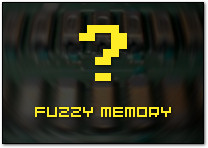Archive for the 'Computer History' Category
[ Retro Scan of the Week ] Running with Computers
Monday, June 17th, 2013[ Retro Scan of the Week ] USB Instructions
Monday, May 27th, 2013 Words cannot express how hard it is to use USB plugs properly.
Words cannot express how hard it is to use USB plugs properly.
This is not particularly retro — in fact, it’s from 2005. But I find it so amusing that I have to share it. I believe this insert (about 5 inches wide) came with a Kodak scanner that my father bought some years ago.
The back side of the paper is blank.
Discussion Topic of the Week: Do you read instruction manuals before using electronic gadgets?
Woman Needs Help with ASCII Banner for Uncle’s Memorial
Wednesday, May 8th, 2013 Just today I received an email asking for help in producing an ASCII-art style printed banner for a memorial service that will take place this Saturday, May 11th, 2013. They will be honoring a lifetime IBM veteran who passed away recently at the age of 69.
Just today I received an email asking for help in producing an ASCII-art style printed banner for a memorial service that will take place this Saturday, May 11th, 2013. They will be honoring a lifetime IBM veteran who passed away recently at the age of 69.
I have a few ideas on how to do it, but I’m short on time this week, so I’m hoping someone out there can help her. Here is her email (posted with permission):
Hello. My uncle recently passed away quite unexpectedly at the age of 69. We are holding his memorial on Saturday, May 11th. I have been racking my brain on a way to honor him at his memorial. My uncle was a lifetime IBM employee and computer pioneer.
In 1979, when I was 9 years old, he gave me a banner for my birthday. It was from the old dot matrix printers. It had a silhouette of Snoopy on the top of his dog house and it said “Happy Birthday Chimene”. I literally thought it was the coolest thing. This was before home computers and home printers for our family. The letters were made with x or o or maybe dashes. Because my brain had no conceptual framework for the world of computers, I literally wondered if it was created by magic.
I would like to have one of these made for my uncle for his memorial. Do you have any idea how I could go about getting this done? I am not tech savvy so I would love to find someone that can do this for me and do it quickly. I know that there would be no better way for me to honor my uncle and I am desperate to find a way to get this done. Any help you can provide would be so greatly appreciated.
Chimene
Post your suggestions or offers to help in the comments, and Chimene will keep an eye on them. I’ll pass along your email address (leave it in the comment form) if she wants to contact you further.
[Update – I helped Chimene construct a banner using “banner” for *nix systems and an old Snoopy ASCII art drawing. She later sent me a photo of the print-out, which she used at the service. ]
[ Retro Scan of the Week ] A Trunk For Your Disks
Monday, May 6th, 2013 An elephant never forgets your Atari 2600 cartridges.
An elephant never forgets your Atari 2600 cartridges.
In a previous Retro Scan, I cataloged one of my least-favorite brands of floppy disk storage boxes. This time, I thought I’d share an ad for the Elephant Memory Systems Trunk, one of my favorite disk storage boxes.
As far as floppy disk box designs go, the Trunk is my favorite mostly because of nostalgia. This was one of the first floppy boxes I ever used; my dad had bought one to store our Atari 800 or Apple II floppies in (can’t remember which, although I still have it in my closet). Compared to other disk boxes, this one feels solid, and the build quality is high.
The Trunk does have one serious drawback, though: The lid covers so much of its outward-facing surface area that it is very hard to pick up and move around without accidentally opening it and spilling its contents on the floor.
Still, it’s a pretty good floppy box. This and the Flip ‘N File.
Discussion Topic of the Week: Estimate how many 5.25″ floppy disks you own. What system(s) are they for?
[ Retro Scan of the Week ] Hacker
Tuesday, April 30th, 2013High-Res Scan of the World’s First Digital Computer Art
Tuesday, April 9th, 2013
Back in January, I wrote an article about the world’s earliest known figurative computer art for The Atlantic. It it is also likely the world’s first digital computer artwork as well.
(Check out this timeline of computer art history to get an idea where this piece fits in.)
The only known physical record of this circa 1956-58 pin-up diagnostic, which ran on SAGE computer systems, comes from a Polaroid photograph snapped by U.S. airman Lawrence A. Tipton in early 1959. Tipton retains the original print, although it will likely go to a museum soon (more on that when it happens).
 The digital image of the photo used in my Atlantic article was provided by Tipton to a SAGE historian over a decade ago. It was previously the highest-quality version of the photo I had access to, and that posed a few problems. Someone (likely Tipton himself) had hastily retouched the image, removing various scratches, and it was not presented in a high enough resolution to examine in detail.
The digital image of the photo used in my Atlantic article was provided by Tipton to a SAGE historian over a decade ago. It was previously the highest-quality version of the photo I had access to, and that posed a few problems. Someone (likely Tipton himself) had hastily retouched the image, removing various scratches, and it was not presented in a high enough resolution to examine in detail.
To remedy that, Tipton was kind enough to make a high resolution scan of the original print and mail it to me on CD-ROM back in February. With his permission, I am providing the high-resolution scan of the pin-up console photo unretouched and unmodified below so that (a) others may learn from it and (b) to ensure that our only record of this important achievement in art is not lost.
[ Continue reading High-Res Scan of the World’s First Digital Computer Art » ]
[ Retro Scan of the Week ] Star Dot Matrix Printer
Monday, April 8th, 2013 The Star Micronics Delta-10 Dot Matrix Printer: Mouse with Machine Gun
The Star Micronics Delta-10 Dot Matrix Printer: Mouse with Machine Gun
My family owned this exact printer. In fact, I think it’s still sitting in my parents’ attic as we speak. If I’m not mistaken, we used it with our Apple IIe system — the one my dad built from a bare circuit board and a set of cloned ROM chips (much like the one in this 2006 VC&G post).
It’s probably the first printer I ever saw in action, likely before I could even walk. I can recall crawling under our computer desk (the printer was on the floor beneath it for some reason) and watching it print out whimsical banners and calendars from a program like Broderbund’s The Print Shop.
But what I remember most about it, of course, was the sound it made: like a screeching robot mouse spraying lead into tractor-feed paper with a tiny machine gun. Like any dot matrix printer, once you hear one in action, the sound will never leave you.
Those were the days.
Of course, I was still using a dot matrix printer until the early 1990s, so I am pretty much scarred for life. Mice everywhere.
Discussion Topic of the Week: What was the first printer you ever owned?
Revisiting Hotline, the 1990s Internet BBS Platform
Tuesday, April 2nd, 2013Back in the mid-late 1990s, an Internet-based BBS platform called Hotline sprung up and quickly spread throughout the Macintosh community. It was basically a client/server BBS software suite that allowed for multi-user chat, file transfers, and message boards.
By the early 2000s, though, Hotline had mostly died out. Today, only a handful of servers remain. But guess what? You can still connect to them — on Windows or a Mac. A new article I wrote for Macworld, “Hotline Revisted,” tells you how.
Have fun. Remember to be kind to the Hotline veterans when you visit.
Predicting the Smartphone in 1989 — as the Smartwatch
Monday, March 25th, 2013
While researching my slideshow on smartwatch history for TechHive last month, I came across an interesting 1989 letter to Computerworld magazine. It was a response to an earlier article in the publication about the inevitability of a wearable watch-sized microcomputer.
I find the letter prescient because its author imagines the consequences of walking around with a full-blown networked computer on your wrist. And he was right about his predictions in every regard except one: instead of computers on our wrists, we’re walking around with computers in our pockets. In other words, smartphones.
But that’s the nature of predicting the future. You can often get the general trends correct without knowing the details. Nobody in 1989 had any idea that the cell phone, instead of the watch, would first become the vehicle through which we’d wear tiny networked computers on our persons almost every hour of the day.
[ Continue reading Predicting the Smartphone in 1989 — as the Smartwatch » ]









